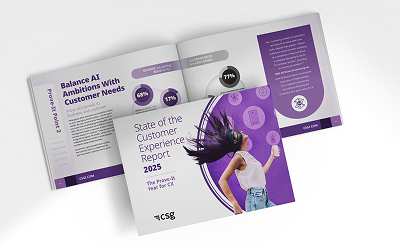While your organization strives to deliver exceptional experiences, you may have noticed that monitoring overall customer experience (CX) is no longer enough to remain competitive. You need to prioritize certain areas within CX to understand your customers better and make informed decisions. That’s what digital experience management (DXM) is all about.
DXM focuses on delivering an optimized customer experience at every digital touchpoint. Meeting that goal requires monitoring customer interactions and identifying opportunities to deliver seamless customer journeys.
What Is Digital Experience Management?
DXM is a method of collecting feedback, tracking engagement and leveraging insights from interactions in digital channels. It’s the holistic management of your online business ecosystem, including the digital experiences of your employees and customers.
DXM involves monitoring all interactions people have with your digital platforms, including your website, social media, intranet and apps. DXM prioritizes experiences that occur in the digital realm. CX includes all digital and physical interactions consumers have with your brand—it’s the complete impact of your engagements.
Key Elements of Digital Experience Management
Digital user journey mapping and personalized content strategy are key components of DXM.
Digital User Journey Mapping
User journey mapping helps you understand interactions in context so you can ultimately deliver exceptional experiences on any digital platform. User journey mapping includes various stages:
-
- Establish goals: Note your goals and objectives in developing personas and consumer mapping.
-
- Define user expectations: Understanding your target audience is vital in DXM. Gather insights from feedback, surveys and user testing questionnaires to identify customer expectations.
-
- Identify customer touchpoints: Examine any digital channel, medium or source where consumers connect with your brand. Focus on touchpoints that have the greatest impact on CX. Once you’ve identified the channels, determine the behaviors, friction points and emotions driving action or causing churn.
-
- Determine resources and mapping types: Identify the resources you need to manage digital experiences now and in the future. Decide whether your maps should focus on current or future state and strategic or tactical situations.
-
- Test and modify journeys: Result analysis is critical in digital journey mapping. Analyzing customer behavior and intent helps you understand how customers use digital channels and identify areas for improvement. Based on these insights, you can modify journeys to meet your customers’ needs.
Content Strategy and Personalization
Relevant, meaningful and personalized content is essential for delivering exceptional customer experiences. Your customers and employees want your organization to interact with them as individuals, which means touchpoints should be tailored to users.
You can use AI to personalize interactions and craft content that’s relevant and engaging.
The Importance of Performance Monitoring in Your Organization
Monitoring the performance of your website and app is vital for optimizing user experiences. Review and analyze various metrics and performance indicators to detect and address any hiccups before they become significant problems.
Website Performance Monitoring
Performance monitoring can help you pinpoint bottlenecks slowing down your website and causing a poor user experience. You can track metrics like:
-
- Page speed: Page speed is the time your pages take to load when users navigate your website. If it’s more than a few seconds, users are likely to leave. You should monitor your page speed and use a performance-optimized hosting solution that compresses your images, minimizes redirects, caches your web pages and eliminates unnecessary plugins.
-
- Responsiveness: Responsive design means that your website’s layout and content (images) automatically adjust to the user’s device and screen size. Mobile responsive design is essential, considering that almost 60% of web traffic comes through mobile phones.
-
- Server response times: Server response time refers to the speed at which your server responds to a request made by a user’s device, like loading a page or accessing a file. Quick response times deliver a pleasant user experience (UX), while slow and unreliable servers lead to delays and frustrating UX.
Mobile App Performance Monitoring
Your organization should monitor how well your mobile application functions and displays on smartphones and tablets. Evaluate factors such as:
-
- Page loading speed
-
- Responsiveness in design and to user requests
-
- Stability and functionality within the app
-
- Ease of navigation and overall user-friendliness of the interface
-
- Engagement metrics and how users are interacting with your app
Digital experience management includes looking at session lengths, conversion rates, retention rates and the number of active users on your app.
Implementing Analytics for Informed Decision-Making
Your organization can’t succeed unless it can make informed decisionss. You should leverage web analytic tools to uncover data-driven insights to optimize UX. You can also use direct feedback methods like surveys to manage and monitor experiences.
Web Analytics Tools
Web analytics tools like Google Analytics track, monitor and analyze your website data. The software tracks how page visitors interact with your site. You can use page views, user demographics, traffic sources and engagement to evaluate your digital user experience.
By understanding how users interact with the site, you can make data-driven decisions that help optimize your website’s performance. For example, you might see many users navigating to your site, browsing for a while and suddenly bouncing when they get to the payment or checkout process and are required to create an account. In that case, you can take steps to simplify the checkout process so users complete their purchase.
User Feedback and Surveys
User surveys provider insights into how consumers interact with your products, services and platforms. You can better meet user expectations and continuously improve experiences by applying the feedback you get.
Collect information about experiences in multiple ways, like surveys, questionnaires or direct communication. You can schedule automated user surveys or have them triggered by actions. For example, you can send out churn surveys when people unsubscribe or delete their accounts. When you understand why users behave the way they do, you can modify processes to repeat positive experiences and reduce negative ones.
Leveraging Responsive Design and Cross-Platform Compatibility
Consumers expect a seamless digital experience across the devices they use. No matter what browser or device people use to interact with your brand, the UX should be pleasant and straightforward. Cross-platform compatibility—your website and app functioning effectively across systems, browsers and devices—enables this seamless experience.
Implementing Responsive Web Design
Cross-platform compatibility is another essential element in software development and web design, as it delivers a consistent UX across different digital environments. To achieve this, you must:
-
- Plan: First, you need to understand your target users, their platforms and behaviors. Use analytics to learn how users interact with your current site.
-
- Design: Incorporate responsive design elements to automatically adjust content to different screen sizes and resolutions.
-
- Test: Use analytic tools and software to regularly monitor and test compatibility across devices, operating systems and browsers. Fix any bugs and smooth friction points as you identify them.
When testing responsiveness and compatibility, you should:
-
- Pay attention to navigation elements
-
- Check the typography and legibility of the font
-
- Consider images, their load speed and whether they’re displaying correctly
Optimizing for Mobile and Tablet Users
Optimize for mobile and tablet users so your website and digital platform:
-
- Look good on smaller screens
-
- Load content rapidly
-
- Make interactions simple and seamless
With 310 million smartphone users in the U.S., your business must think mobile-first when designing elements. You can optimize your website for mobile devices by:
-
- Testing your site’s mobile friendliness using Google’s mobile site checking tool
-
- Choosing responsive themes and plugins or custom CSS
-
- Checking your website’s core vitals to minimize technical aspects that hamper UX
-
- Improving your site’s loading times by minifying code, compressing images and implementing caching
-
- Redesigning your pop-ups for mobile devices
-
- Selecting a reliable web hosting service
Amplifying Security in Digital Experience Management
Businesses must implement strong security measures to protect consumer data. . Your website, mobile app and online services collect and process vast amounts of sensitive information. That means your systems need robust security to safeguard data from unauthorized access, breaches and threats. Employ security measures like:
- Secure sockets layer (SSL) encryption
- User authentication
- Firewalls
- Vulnerability assessments
- Routine security audits
- Secure coding and system architecture
Prioritizing security and data privacy will help you build trust with consumers while complying with regulations like the General Data Protection Regulation (GDPR).
Emerging Trends in Digital Experience Management
AI and machine learning will continue to play vital roles in DXM. AI technology will allow personalized recommendations and experiences and simplify the secure management of data within the scope of data privacy regulations like the GDPR.
Automation will continue to influence DXM and streamline user journey management significantly.
Steps to Implement Effective Digital Experience Management
Creating a comprehensive DXM strategy allows you to personalize customer experiences, cover all digital touchpoints, deliver consistent service across channels and make powerful data-driven decisions. Summing up what we’ve discussed so far, here are the steps you can take to implement compelling digital experience management:
-
- Understand the why and how of experiences by investigating experience and operational data.
- Use customer journey analytics to help you understand essential customer journeys
- Identify your target audience across your digital channels
- Implement easy ways to get user feedback
- Track and evaluate potential friction points, especially high-level ones
- Monitor the latest trends and customer behaviors
- Select a robust and streamlined digital experience platform
- Establish clear goals, objectives and key performance indicators to track the effectiveness of your DXM initiatives
Optimize Your Digital Experience Management
Optimize your digital experience management with CSG’s award-winning customer experience management platform. For over four decades, we’ve been helping thousands of organizations streamline their processes and deliver unbeatable customer experiences.
We’re here to simplify the complex.











